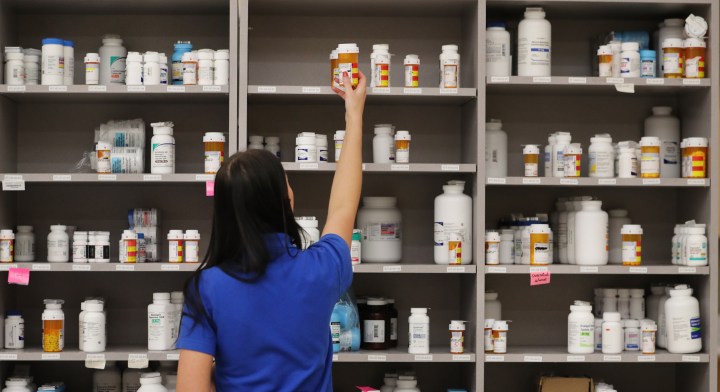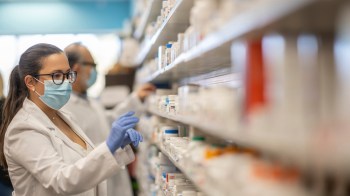
How are companies like GoodRx able to provide drug discounts?
Share Now on:
How are companies like GoodRx able to provide drug discounts?

This is just one of the stories from our “I’ve Always Wondered” series, where we tackle all of your questions about the world of business, no matter how big or small. Ever wondered if recycling is worth it? Or how store brands stack up against name brands? Check out more from the series here.
Listener Kristen Suzda from Philadelphia asks:
How does GoodRX work? Does my insurance company want me to use it because then they don’t have to pay for anything and I spend money that doesn’t count against my deductible? Who pays for the drugs in the GoodRx scenario? What’s actually the best way to buy the prescriptions I need in the most affordable way?
Between 2022 and 2023, prices rose for a staggering 4,200 drugs, with the average drug rising 15%, or $590 per drug.
Most U.S. adults take at least one prescription drug, according to a 2023 poll from KFF, a nonprofit health research organization. More than a quarter say medication is difficult to afford, and a majority called prescription drug costs “unreasonable.”
To help people save on drug costs, there are companies that offer prescription discount cards and coupons, including SingleCare, RxSaver and perhaps the most well-known among them, GoodRx.
Some companies charge a membership fee and the available drugs can vary, said Cindy Parks Thomas, professor and associate dean for research at the Brandeis University Heller Graduate School.
But in general, here’s how it works: Search for a drug on the company’s app or website. If it’s available, you’ll be shown a list of pharmacies where you can use a coupon to get the drug at a discount. GoodRx, for example, showed that 30 tablets of atorvastatin — used to treat high cholesterol — cost just $2.60 with its coupon at Vons. The retail price? $46, or about 18 times the cost, at the time of this writing.
At GoodRx, you can’t use a coupon in combination with health insurance, although you can try to get reimbursed.
How companies like GoodRx work
How are drug coupon companies able to offer those discounts in the first place? It’s a complicated, opaque process that’s part of an even more complicated, opaque health care system.
Kevin Schulman, a professor at the Stanford University School of Medicine, said that behind the scenes, the manufacturer offers a discount or rebate to an intermediary known as a pharmacy benefits manager, or PBM.
PBMs are companies that serve as middlemen between drug manufacturers, insurers, big employers and pharmacies, negotiating with drugmakers to get the lowest prescription price. PBMs are like real estate agents, an economist told Marketplace in 2018, handling complicated details.
Schulman said that behind the scenes, the manufacturer offers a rebate to the PBM, who then takes a cut of that rebate. In other words, instead of passing off the full discount, the PBM pockets some of the money. As critics have pointed out, it’s unclear how much PBMs take from the pot.
If you have health insurance, the PBM then passes on the remaining rebate to your insurer.
GoodRx doesn’t negotiate its prices with pharmacies; it uses PBMs for that. So how does GoodRx make money?
By getting a cut of the price PBMs negotiate for them, similar to how PBMs make money, explained Reshma Ramachandran, an assistant professor at the Yale School of Medicine.
A flow chart on Drug Channels, an online site that covers the pharmaceutical industry, explains the different players in America’s drug distribution and reimbursement system and another way PBMs make money. When you use a discount card, the PBM receives a fee from the pharmacy, and the PBM will then share some of this fee with the discount card vendor that steered you to that pharmacy.
But in this system, some players may end up missing out on revenue, like pharmacies or large chains, and leave the discount card networks, said Stacie Dusetzina, a professor at Vanderbilt University Medical Center.
For example, the Los Angeles Business Journal reported that in 2022, Kroger “stopped accepting GoodRx discounts.”
PBMs in particular have gotten backlash, with critics saying that they’re responsible for rising retail drug prices.
“The PBMs say the drug manufacturers set the list price of the drug, and so it’s the drug manufacturers’ fault,” said Schulman of Stanford University. “The drug manufacturers say the PBMs are demanding greater and greater rebates, and so they have to raise the list prices to pay the rebates.”
Three PBMs control a majority of the market: Express Scripts, CVS Caremark and Optum Rx. They have negotiating power because if manufacturers “want to sell their products, they need good formulary placement,” Schulman explained. (A formulary is a list of drugs, created by PBMs, that health insurance will cover.)
PBMs add “another layer of complexity” to a market that’s already opaque, said Cindy Parks Thomas of Brandeis University.
But Thomas said there are benefits to PBMs — they can manage your drugs and can let you know if a drug you’re taking could negatively interact with another drug.
What should you do when looking for prescriptions?
Would insurance companies prefer that you use GoodRx instead of insurance? One way insurance companies would benefit is that they wouldn’t have to pay any money toward your prescription, explained Dusetzina.
In some cases, GoodRx’s discount prices might be a better deal than what your insurance company will offer.
But one tough dilemma patients might have to deal with is figuring out whether it’s worth using a coupon instead of insurance to fill their prescription, since you can’t use a GoodRx coupon in combination with your insurance, Dusetzina said.
“If you’re using medications every month, and you have a deductible, you have to pay a certain amount before your health insurance benefit kicks in,” Dusetzina said.
She explained you’ll have to do the math and decide whether to pay more upfront using health insurance for your medication, since in the long run, it might be cheaper to use your insurance. GoodRx drug prices can also fluctuate, meaning that you might end up spending more than you had initially planned if you forgo insurance and use a coupon.
When shopping around, Dusetzina recommends talking with your pharmacist and doctor about your options.
“Sometimes you can find surprising things. I had a prior experience where there was a medication that was recommended that was very expensive, and the pharmacist said, ‘Oh, if you take these two low-cost over-the-counter drugs, those do the same thing,’” Dusetzina said.
Ramachandran of Yale said along with companies like GoodRx, you can also look into manufacturer copay cards, which lower the price of brand-name drugs, and patient assistant programs, which provide financial help to people with low incomes.
Ramachandran added that retailers also offer low-cost or discounted drugs, such as Walmart, which has a list of generic medications for $4, and Amazon, which has a $5-a-month prescription drug subscription program called RxPass for Prime members. There’s also Mark Cuban’s Cost Plus Drug, a fairly recent entrant into the health care space that sells discounted drugs.
“These are all short-term solutions, like a Band-Aid to the larger problem of prescription drug pricing and the factors that limit access to these drugs. But they’re the things that we have in the short term to be able to provide immediate relief,” Ramachandran said.
There’s a lot happening in the world. Through it all, Marketplace is here for you.
You rely on Marketplace to break down the world’s events and tell you how it affects you in a fact-based, approachable way. We rely on your financial support to keep making that possible.
Your donation today powers the independent journalism that you rely on. For just $5/month, you can help sustain Marketplace so we can keep reporting on the things that matter to you.


















